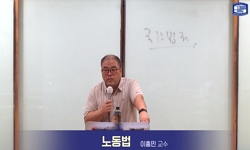The issues involving the wages have always resulted in conflicts between the workers and employers since the workers want to be paid more while the employers want to pay less. For the worker, the wages is not only the essential means of living but als...
http://chineseinput.net/에서 pinyin(병음)방식으로 중국어를 변환할 수 있습니다.
변환된 중국어를 복사하여 사용하시면 됩니다.
- 中文 을 입력하시려면 zhongwen을 입력하시고 space를누르시면됩니다.
- 北京 을 입력하시려면 beijing을 입력하시고 space를 누르시면 됩니다.
임금의 개념과 제도상 문제점에 관한 연구 : 근로기준법과 최저임금법을 중심으로 = A study of the concept of wages and related issues
한글로보기https://www.riss.kr/link?id=T12517223
- 저자
-
발행사항
대구 : 경북대학교 법학전문대학원, 2011
-
학위논문사항
학위논문 (박사) -- 경북대학교 법학전문대학원 , 법학과 공법전공 , 2011. 8
-
발행연도
2011
-
작성언어
한국어
- 주제어
-
DDC
344.0121 판사항(22)
-
발행국(도시)
대구
-
형태사항
vi, 252 p. ; 26 cm
-
일반주기명
참고문헌: p. 241-248
- 소장기관
-
0
상세조회 -
0
다운로드
부가정보
다국어 초록 (Multilingual Abstract)
The issues involving the wages have always resulted in conflicts between the workers and employers since the workers want to be paid more while the employers want to pay less. For the worker, the wages is not only the essential means of living but also the basis for the self-realization through the social and cultural activities. The wage therefore is the most important element of conditions of the employment, and the protection of the right with regard to the wage is the essence among Acts related to the labor.
In Korea, Labor Standards Act provides the basic concept of wages in its Article 2 (1) - 5 for the protection of workers. The wages in the Article means wages, in its salaries, and any other money and valuable goods an employer pays to a worker for his/her work, regardless of how such payments are termed. Based on this definition, the wages are again divided into the average wages(Labor Standard Act §2 (1) - 6) and the ordinary wages(Enforcement Decree of the Labor Standard Act §6(1)). The average wages are the basis of computing the retirement pay or the allowance during business suspension which are usually connected to the livelihood, and the ordinary wages are that of calculating allowances for the advance notice of discharge or the extended working hours.
One controversial issue is with regard to interpreting Article 2 (1) - 5 which provides wages as “any other money and valuable goods an employer pays to a worker for his/her work.” The ambiguity of the provision causes the conflict between workers and employers as well as inconsistencies of the court decisions and the administrative interpretations.
Taken social and legal viewpoints, the court decisions, academic theories, and foreign legislations into consideration, the concept of wages or the duty to pay wages should be set up not based on the practical provision of the labor but based on the basic relationship between a worker and an employer including the practical labor provision. That is to say, the concept shall be extended because employers bind workers under their business, which means that the employers shall pay for the established relationship between two in addition to the hours for which employees work for them.
Accordingly, the definition of the wages in §2(1) - 5 of Labor Standards Act shall be changed from “any other money and valuable goods an employer pays to a worker for his/her work” into “any other money and valuable goods an employer pays to a worker for their relationship.” This enlarged concept will include all money and valuable goods arising from the working relationship other than cost-compensatory pay and pays which cannot be wages in nature.
In addition, the ordinary wages which have been provided in the Enforcement Decree shall be provided in the Act. The ordinary wages include the regular pays and irregular ones. However, it is necessary to be enacted in the Act for protecting workers if a payment is regular, uniform and fixed. The suggestion for the enactment in the Act is as follows; “(1) The ordinary wages means hourly wages, daily wages, weekly wages, monthly wages, yearly wages, or contract wages which are determined to be paid periodically or fixedly(including fixed conditional pays and periodic bonuses) to a worker for his/her prescribed work or whole work by a year, regardless of how such payments are termed. The preceding does not include money and valuables which shall not be wages in nature and fluctuant wages which are paid in proportion to a worker’s achievement. (2) The specific standard for the computation of the ordinary pursuant to paragraph (1) shall be prescribed by the Presidential Decree.”
It is expected that the employers would bear high labor costs if the regular and fixed pays are included in the ordinary wages. In order to minimize this side-effect, the supplement policies such as not paying for weekly day-off, adjusting the extra charge, or encouraging annual paid vacation are need to set up.
The best way to resolve the controversies involving the concept of wages and the revision with regard to the ordinary wages is the overall amendment of Labor Standards Act. It is however thought that the overall amendment is not easy to be accomplished soon because workers and employers’ interest is being opposed sharply. The introduction of the report obligation system of the labor contract and the payroll book is a good alternative for protecting the weak and the vulnerable, and preventing the conflict between labor and management until amendment of the Act.
In conclusion, the reestablishment of the concept of the wages, the revise of the ordinary wages, and the introduction of supplement policies to deal with related issues will result in the fair and resonable wages for what workers do for the employers, leading the just society in accordance with the constitutional value we seek.
목차 (Table of Contents)
- 제1장 서 론 1
- 제1절 연구의 목적 1
- 제2절 연구의 범위와 방법 4
- 제2장 임금의 법리 6
- 제1장 서 론 1
- 제1절 연구의 목적 1
- 제2절 연구의 범위와 방법 4
- 제2장 임금의 법리 6
- 제1절 노동과 임금의 인격실현성 6
- Ⅰ. 노동의 의미와 임금근로자 6
- 1. 노동의 의미 6
- 2. 임금근로자 발생 8
- Ⅱ. 임금의 인격 실현성 13
- 1. 임금을 보는 관점 13
- 2. 임금의 기능 16
- 3. 노동인격 실현의 핵심 17
- 제2절 임금개념 19
- Ⅰ. 실정법상 임금개념 19
- 1. 문제제기 19
- 2. 헌법상 임금의 개념 20
- 3. 근기법상 임금의 개념 26
- 4. 임금개념 논의의 구체적 실익 28
- 5. 경영학 및 실무상의 임금개념 29
- Ⅱ. 임금의 본질과 법적성질 31
- 1. 임금의 본질 31
- 2. 판례의 태도 36
- 3. 임금의 법적 성질 37
- Ⅲ. 임금성 판단 48
- 1. 판례상 임금성 48
- 2. 임금성 사례 56
- 3. 임금체계변화와 근로관계의 대가 58
- 4. 휴업수당과 근로관계의 대가 60
- Ⅳ. 소결(임금은 근로관계의 대가) 60
- 제3장 임금제도와 최저임금제 63
- 제1절 현황과 문제점 63
- 제2절 근로기준법상 임금제도 64
- Ⅰ. 통상임금 64
- 1. 통상임금의 개념과 취지 64
- 2. 판례 및 행정해석의 태도 67
- 3. 통상임금성 사례 88
- 4. 소결 90
- Ⅱ. 평균임금 91
- 1. 문제제기 91
- 2. 평균임금의 개념 및 취지 92
- 3. 평균임금의 산정방법 93
- 4. 판례 및 행정해석의 태도 103
- 5. 평균임금성 사례 109
- 6. 소결 113
- 제3절 최저임금법상 최저임금제도 114
- Ⅰ. 서설 114
- Ⅱ. 저임금 출현과 최저임금 115
- Ⅲ. 최저임금제도의 의의 및 목적 115
- Ⅳ. 최저임금과 공적부조와의 관계 116
- Ⅴ. 최저임금결정의 요소 117
- 1. 생계비 117
- 2. 유사 임금 117
- 3. 노동생산성 및 소득분배율 118
- Ⅵ. 다양한 최저임금결정 형태 118
- 1. 최저임금과 노동형태 118
- 2. 고령자의 최저임금 119
- 3. 최저임금제 유형 119
- Ⅶ. 최저임금 미달여부의 판단과 효력 121
- 1. 최저임금 미달여부 판단 121
- 2. 최저임금 범위와 통상임금과의 관계 124
- Ⅷ. 최저임금 산입 사례 125
- 1. 사실관계 125
- 2. 검토 126
- Ⅸ. 소결 128
- 제4장 외국의 임금의 개념과 제도 129
- 제1절 서설 129
- 제2절 임금의 개념 129
- Ⅰ. ILO 129
- Ⅱ. 미국 130
- Ⅲ. 독일 133
- Ⅳ. 일본 136
- Ⅴ. 프랑스 140
- Ⅵ. 소결 141
- 제3절 임금의 제도 143
- Ⅰ. ILO 143
- Ⅱ. 미국 143
- 1. 개요 143
- 2. 연장근로수당 145
- 3. 일반급에 포함되는 임금의 범위 148
- 4. 고령 및 퇴직자 등을 위한 기여금 154
- 5. 시간외근로수당 등 154
- Ⅲ. 독일 156
- 1. 개념 156
- 2. 임금인지가 문제되는 경우의 해석 157
- 3. 법률의 규정 158
- 4. 보수의 종류와 임금의 대상 및 산정 158
- 5. 보수의 산정 158
- 6. 특별보수 159
- Ⅳ. 일본 162
- 1. 통상임금 162
- 2. 평균임금의 정의 168
- Ⅴ. 소결 174
- 제4절 최저임금 177
- Ⅰ. ILO 177
- Ⅱ. 미국 177
- Ⅲ. 독일 178
- Ⅳ. 일본 179
- Ⅴ. 프랑스 181
- Ⅵ. 소결 182
- 제5장 임금의 개념 및 제도의 문제점과 개선방안 183
- 제1절 문제점 183
- Ⅰ. 임금개념 183
- Ⅱ. 임금제도 184
- 1. 개괄 184
- 2. 통상임금 185
- 3. 평균임금 193
- 4. 판례와 행정해석의 불일치 196
- 5. 최저임금 201
- 6. 취약계층 임금보호 205
- 제2절 개선방안 207
- Ⅰ. 서설 207
- Ⅱ. 기존의 논의 207
- 1. 노사관계제도 선진화연구위원회 선진화방안 207
- 2. 노동부의 임금개정논의 209
- 3. 표준임금제의 논의 210
- 4. 소결 212
- Ⅲ. 개선 방안 213
- 1. 근로관계 대가로서의 임금 정의 213
- 2. 통상임금 정의를 모법으로 격상 219
- 3. 통상임금 정의 변경 219
- 4. 평균임금 산정범위 및 방법 변경 225
- 5. 판례와 행정해석 일치 227
- 6. 최저임금범위와 통상임금범위 일치 228
- 7. 근로계약·임금대장 신고제 229
- 제6장 결 론 237
- 【 참고 문헌 】 241
- 【 Abstract 】 249












